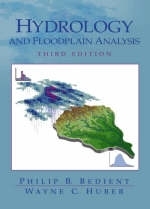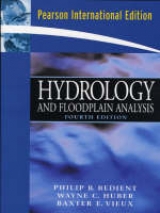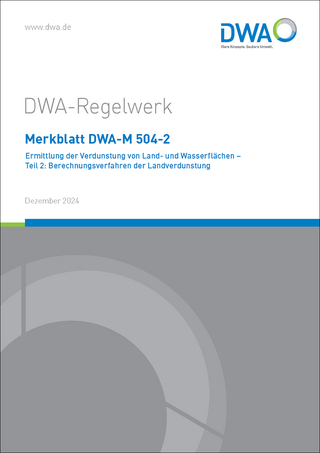
Hydrology and Floodplain Analysis
Pearson (Verlag)
978-0-13-032222-7 (ISBN)
- Titel erscheint in neuer Auflage
- Artikel merken
For undergraduate and graduate courses in Hydrology.
This text offers a clear and up-to-date presentation of fundamental concepts and design methods required to understand hydrology and floodplain analysis. It addresses the computational emphasis of modern hydrology and provides a balanced approach to important applications in watershed analysis, floodplain computation, flood control, urban hydrology, stormwater design, and computer modeling. Includes HEC-HMS, HEC-RAS, and SWMM models plus GIS and radar rainfall.
Philip B. Bedient is the Herman Brown Professor of Engineering, with the Department of Civil and Environmental Engineering, Rice University, Houston, TX. He received the Ph.D. degree in environmental engineering sciences from the University of Florida, Gainesville. He is a registered professional engineer and teaches and performs research in surface and ground water hydrology and flood prediction systems. He has directed 45 research projects over the past 26 years, and has written over 120 journal articles and conference proceedings over the past 25 years. He has also written four textbooks in the area of surface and groundwater hydrology. Dr. Bedient has worked on a variety of hydrologic problems, including river basin analyses, major floodplain, studies, groundwater contamination models, and hydrologic/GIS models in water resources. He has been actively involved in developing computer systems for flood prediction and warning, and recently directed the development of a real-time flood alert system (FAS) funded by the Texas Medical Center in Houston. The FAS is based on converting NEXRAD radar data directly to rainfall in a GIS framework, which is then used to predict peak channel flows. Dr. Bedient has overseen the monitoring, modeling, and remediation at numerous hazardous waste sites, including six Superfund sites, and U.S. Air Force bases in five states. He has extensive experience in contaminant transport at sites impacted with chlorinated solvents and fuels. He has served on two National Academy of Science committees relating to environmental remediation and technology, and has received research funding from the EPA, the U.S. Department of Defense, the State of Texas, the U.S. Army Corps of Engineers, and the City of Houston. Wayne C. Huber is Professor of Civil, Construction, and Environmental Engineering at Oregon State University, Corvallis. His doctoral work at the Massachusetts Institute of Technology dealt with thermal stratification in reservoirs, for which he received the Lorenz G. Straub Award from the University of Minnesota and the Hilgard Hydraulic Prize from the American Society of Civil Engineers (ASCE). He is a member of several technical societies and has served several administrative functions within the ASCE. He is the author of over 120 reports and technical papers, is a registered professional engineer, and has served as a consultant on numerous studies done by public agencies and private engineering firms. Beginning at the University of Florida and continuing at Oregon State University, Dr. Huber's research has included studies of urban hydrology, stormwater management, nonpoint source runoff, river basin hydrology, lake eutrophication, rainfall statistics, and hydrologic and water quality modeling. He is one of the original authors of the EPA Storm Water Management Model and has helped to maintain and improve the model continuously since 1971. Dr. Huber is an internationally recognized authority on runoff quantity and quality processes in urban areas.
(NOTE: Each chapter concludes with Summary, Problems, and References.)
1. Hydrologic Principles.
Introduction to Hydrology. Hydrologic Cycle. Weather Systems. Precipitation. Evaporation and ET. Infiltration Loss. StreamFlow and the Hydrograph. Hydrologic Measurement.
2. Hydrologic Analysis.
Watershed Concepts. Rainfall-Runoff. Hydrograph Analysis. Unit Hydrograph Theory. Synthetic Unit Hydrograph Development. Applications of Unit Hydrographs. Conceptual Models. Snowfall and Snowmelt. Green and AMPT Infiltration Method.
3. Frequency Analysis.
Introduction. Probability Concepts. Random Variables and Probability Distributions. Return Period or Recurrence Interval. Common Probabilistic Models. Graphical Presentation of Data. Related Topics.
4. Flood Routing.
Hydrologic and Hydraulic Routing. Hydrologic River Routing. Hydrologic Reservoir Routing. Governing Equations for Hydraulic River Routing. Movement of a Flood Wave. Kinematic Wave Routing. Hydraulic River Routing.
5. Hydrologic Simulation Models.
Introduction to Hydrologic Models. Steps in Watershed Modeling. Description of Major Hydrologic Models. HEC-1 Flood Hydrograph Package. Input and Output Data for HEC-1. Introduction to HEC-HMS. HEC-HMS Watershed Analysis: Case Study.
6. Urban Hydrology.
Characteristics of Urban Hydrology. Review of Physical Processes. Rainfall Analysis. Methods for Quantity Analysis. Sewer System Hydraulics. Control Options. Operational Computer Models. Case Study.
7. Floodplain Hydraulics.
Uniform Flow. Uniform Flow Computations. Specific Energy and Critical Flow. Occurrence of Critical Depth. Nonuniform Flow or Gradually Varied Flow. Gradually Varied Flow Equations. Classification of Water Surface Profiles. Hydraulic Jump. Introduction to the HEC-2 Model. Theoretical Basis for HEC-2. Basic Data Requirements. Optional HEC-2 Capabilities. Input and Output Features. Example of HEC-2 Input. Introduction to HEC-RAS.
8. Ground Water Hydrology.
Introduction. Properties of Ground Water. Ground Water Movement. Flow Nets. General Flow Equations. Dupuit Equation. Streamlines and Equipotential Lines. Unsaturated Flow. Steady-State Well Hydraulics. Unsteady Well Hydraulics. Water Wells. Ground Water Modeling Techniques.
9. Design Issues in Hydrology.
Introduction. Design Rainfalls. Small Watershed Design. Design Hydrographs for Pipes, Overland Flows, and Channels. Detention Pond Design for Flood Control. Floodplain Analysis and Design at the Woodlands—Case Study.
10. GIS Applications in Hydrology.
Introduction to GIS. General GIS Concepts. Digital Representation Hydrologic Parameters. Digital Representation of Topography. GIS-Based Hydrology and Hydraulics. Common GIS Software Programs.
11. Radar Rainfall Applications in Hydrologic.
Introduction. Radar Estimation of Rainfall. WSR-88D Radar System. Real-Time WSR-88D Precipitation Products. Radar to Gage Calibration. Linkages with Hydrologic Modeling.
12. Floodplain Management Issues in Hydrology.
Introduction. The Era of Federal Structural Flood Control Measures. The Federal Emergency Management Agency. Floodplain Management Issues. Structural Methods of Flood Control. The Flood Control Paradox. Nonstructural Methods of Flood Control. Clear Creek Case Study: A GIS-Based Approach.
Appendix A. Symbols and Notation.
Appendix B. Metric Conversion Factors (SI Units to U.S. Customary).
Appendix C. Properties of Water.
Appendix D. Normal Distribution Tables.
Appendix E. Useful Hydrology-Related Internet Links.
Glossary.
Index.
| Erscheint lt. Verlag | 7.3.2002 |
|---|---|
| Sprache | englisch |
| Maße | 185 x 241 mm |
| Gewicht | 1256 g |
| Themenwelt | Naturwissenschaften ► Geowissenschaften ► Hydrologie / Ozeanografie |
| ISBN-10 | 0-13-032222-9 / 0130322229 |
| ISBN-13 | 978-0-13-032222-7 / 9780130322227 |
| Zustand | Neuware |
| Informationen gemäß Produktsicherheitsverordnung (GPSR) | |
| Haben Sie eine Frage zum Produkt? |
aus dem Bereich



